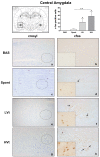Injurious mechanical ventilation affects neuronal activation in ventilated rats
- PMID: 21569477
- PMCID: PMC3218983
- DOI: 10.1186/cc10230
Injurious mechanical ventilation affects neuronal activation in ventilated rats
Erratum in
-
Erratum to: Injurious mechanical ventilation affects neuronal activation in ventilated rats.Crit Care. 2015 Oct 27;19:379. doi: 10.1186/s13054-015-1076-5. Crit Care. 2015. PMID: 26506991 Free PMC article. No abstract available.
Abstract
Introduction: Survivors of critical illness often have significant long-term brain dysfunction, and routine clinical procedures like mechanical ventilation (MV) may affect long-term brain outcome. We aimed to investigate the effect of the increase of tidal volume (Vt) on brain activation in a rat model.
Methods: Male Sprague Dawley rats were randomized to three groups: 1) Basal: anesthetized unventilated animals, 2) low Vt (LVt): MV for three hours with Vt 8 ml/kg and zero positive end-expiratory pressure (ZEEP), and 3) high Vt (HVt) MV for three hours with Vt 30 ml/kg and ZEEP. We measured lung mechanics, mean arterial pressure (MAP), arterial blood gases, and plasma and lung levels of cytokines. We used immunohistochemistry to examine c-fos as a marker of neuronal activation. An additional group of spontaneously breathing rats was added to discriminate the effect of surgical procedure and anesthesia in the brain.
Results: After three hours on LVt, PaO2 decreased and PaCO2 increased significantly. MAP and compliance remained stable in MV groups. Systemic and pulmonary inflammation was higher in MV rats than in unventilated rats. Plasma TNFα was significantly higher in HVt than in LVt. Immunopositive cells to c-fos in the retrosplenial cortex and thalamus increased significantly in HVt rats but not in LVt or unventilated rats.
Conclusions: MV promoted brain activation. The intensity of the response was higher in HVt animals, suggesting an iatrogenic effect of MV on the brain. These findings suggest that this novel cross-talking mechanism between the lung and the brain should be explored in patients undergoing MV.
Figures







References
-
- Jackson JC, Girard TD, Gordon SM, Thompson JL, Shintani AK, Thomason JW, Pun BT, Canonico AE, Dunn JG, Bernard GR, Dittus RS, Ely EW. Long-term cognitive and psychological outcomes in the Awakening and Breathing Controlled trial. Am J Respir Crit Care Med. 2010;182:183–191. doi: 10.1164/rccm.200903-0442OC. - DOI - PMC - PubMed
-
- Vaneker M, Joosten LA, Heunks LM, Snijdelaar DG, Halbertsma FJ, van Egmond J, Netea MG, van der Hoeven JG, Scheffer GJ. Low-tidal-volume mechanical ventilation induces a toll-like receptor 4-dependent inflammatory response in healthy mice. Anesthesiology. 2008;109:465–472. doi: 10.1097/ALN.0b013e318182aef1. - DOI - PubMed
Publication types
MeSH terms
Substances
LinkOut - more resources
Full Text Sources
Other Literature Sources

